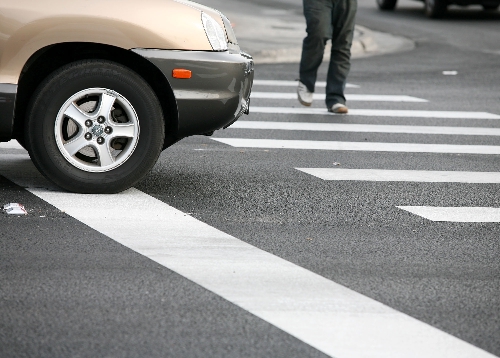State taking steps to protect walkers

Here’s the scenario: The signal turns green and the lane filled with through traffic is stopped dead behind one car turning right. You eye the pedestrian walk timer all the way down to zero, at which time the signal is yellow and nobody has budged. Then you shoot daggers at the gray-haired man who eased across the street, holding up everybody else.
Everybody in this town has had to experience it. It’s not the fault of the poor guy who relies on his feet rather than his wheels. It’s not the fault of drivers that designated turn lanes were not in Las Vegas visionaries’ plans.
Scenes like that, as well as when pedestrians step out in front of cars or impatient drivers blast through crosswalks, have created a deadly relationship between motorists and pedestrians.
And as one transportation official said, “When it’s a car versus a pedestrian, guess who is going to win?”
The high number of pedestrian fatalities, as well as fatal vehicle accidents throughout the state, is why transportation experts, law enforcement and emergency responders gathered in Las Vegas on Thursday to unveil their new Zero Fatalities program.
The goal of this Nevada Department of Transportation-led program is to reduce the number of fatalities on the state’s roads to zero by pounding into the heads of motorists and pedestrians the risks of inattentiveness and alcohol. The public service announcements will also include reminders to buckle up and drive the speed limit.
Zero. Seriously.
“Is it doable? I definitely think so. I really think so,” said Susan Martinovich, director of the state transportation agency.
That is difficult to imagine. The number of pedestrians killed each year has astounded me since I moved to Las Vegas more than a decade ago.
Are the roads too dark? Are there not enough crosswalks? Are pedestrians careless, drunk? Are motorists careless? Distracted? Drunk?
Whatever the case, it’s a serious problem.
Between 2005 and 2009, 258 pedestrians were killed in Nevada, according to the state’s Strategic Highway Safety Plan, and most of those accidents occurred in Clark County.
In 2009, Nevada had 35 pedestrian deaths, a rate of 2.08 per 100,000 people, close to double the national average, according to the website Transportation for America.
According to figures provided by the Governors Highway Safety Association, in the first six months of 2010 — the last statistics available — there were 12 pedestrian fatalities in Nevada.
It really is a combination of several factors.
For example, engineers study a road layout and decide where crosswalks belong, typically at intersections. But where experts say they belong doesn’t always jibe with where the users feel they belong. With some of our blocks seeming like they are a mile long, who is going to step off a bus and wander 300 yards to an intersection when the shopping center is directly across the street?
“We need to start thinking not only as engineers but as users.” Martinovich said. “We need to find a balance.”
Seeing jaywalkers in this town has become more common than spotting bad Elvis impersonators. Not surprisingly, 49 percent of pedestrian-vehicle accidents that result in death or serious injury are due to improper crossings.
Still, the numbers show that 14 percent of pedestrians hit are actually using the crosswalks. Understandable. You’ve probably also seen this: A vehicle stops for a pedestrian in the crosswalk, but drivers in neighboring lanes ignore that car and blow through the walkway. Pedestrians, likely feeling safe because they were acknowledged by one driver, are struck.
This city was designed to move cars, not pedestrians or even bicyclists. Most surface streets are wide and have few obstacles, so they essentially become highways. That, according to the Regional Transportation Commission, was the demand of our car-loving public.
“In the past, the demand from our public to design engineers is to make cars move faster, remove impediments for cars to move faster and improve traffic flow,” said Jacob Snow, general manager of the commission. “That emphasis, focus and pressure on civil engineers has translated into having our roads designed for one mode of transportation and that is automobiles.”
Then you have the tourist element.
“When you have visitors who are unfamiliar with the streets and roads, and a lot of them stay out late and mix alcohol, that contributes a great deal to our higher-than-average rate,” Snow said.
An avid bicyclist, Snow acknowledges he avoids some roads in town for fear of his safety.
Pedestrians probably feel the same way. The Transportation Commission recently has placed an emphasis on “complete streets,” which means improvements to aging roads will include wider pedestrian-friendly sidewalks and bicycle lanes.
It’s all part of the effort to pry people from their vehicles and encourage them to use other modes of transportation.
The question is, will that help achieve the goal of zero fatalities in our state, or only add to the statistics?
The aim to have zero deaths on our roads is admirable, but also lofty and improbable — even with repeated public service announcements that say, for example, “Don’t run over pedestrians.”
If you have a question, tip or tirade, call Adrienne Packer at 702-387-2904, or send an e-mail to roadwarrior@reviewjournal
.com. Please include your phone number.